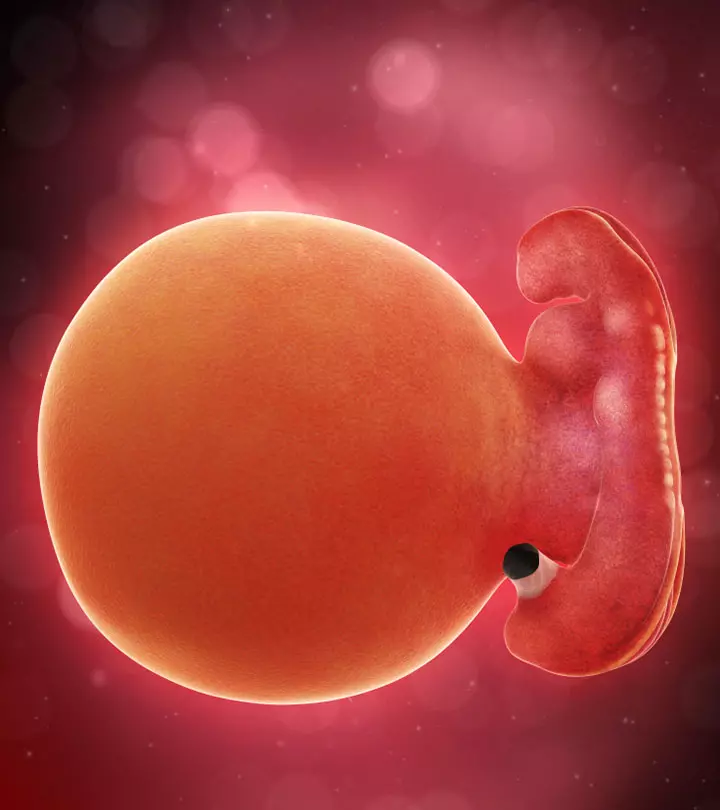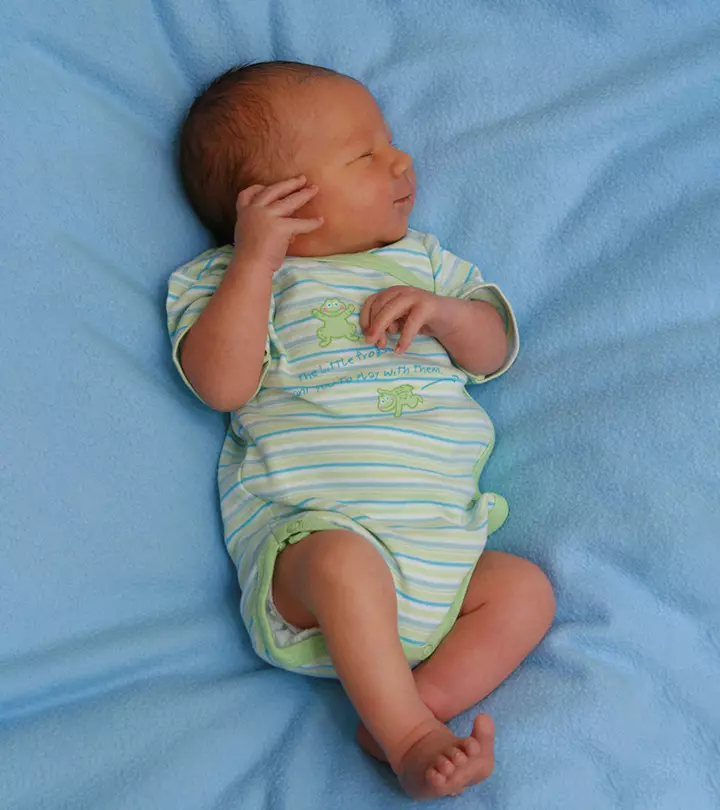
Image: ShutterStock
When a head injury causes the skull bone to crack, it is called a skull fracture.

Skull fractures in babies can be caused by several reasons. However, using instruments during childbirth is the most common. In addition, for some babies, skull fracture may lead to brain damage.
The severity of skull fractures can vary from mild to severe, where mild fractures cause no symptoms and often heal without medical intervention. Nevertheless, experts advise medical consultation for any head injury in babies, irrespective of its severity. A baby vomiting repeatedly after a head injury or trauma may indicate intracranial bleeding, which may not be externally discernible.
Keep reading to know about the types of skull fractures in infants and their causes, symptoms, treatment, and long-term effects.
Key Pointers
- A head injury due to a fall or blow may cause a skull fracture in babies.
- The types include diastatic, linear, depressed, and basilar skull fractures.
- Mild skull fracture in babies may produce symptoms such as irritability, abnormal eye movements, or sleeplessness, while severe fractures may cause swelling or depression on the head.
- The treatment is planned based on the severity of the injury.
How Do Skull Fractures Occur In Infants?

Image: Shutterstock
Concussion from a fall and a blow to the head are the common causes of skull fractures in babies. Some could have fractures or a cracked skull due to motor vehicle accidents or other traumas. Child abuse may also be a reason for skull fractures in some babies.
Although a baby’s skull is flexible to undergo molding during delivery, some may get fractures during delivery. Improper use of forceps or vacuum-assisted deliveries may cause a skull fracture.
Larger head size or breech deliveries are also associated with skull fractures in newborns. However, they are mostly rare and usually occur in vaginal deliveries without any interventions.
Skull bones have inner and outer tables with very thin layers of bone marrow. Sometimes, only the outer table has the fracture, so they are not serious.
 Quick tip
Quick tipTypes Of Skull Fractures
Skull fractures are of four types (1).
- Diastatic skull fractures occur along the suture, which are points where the skull bones meet. Newborns and older infants are more prone to diastatic fractures than others. This fracture may expand the suture lines from their normal size.
- Linear skull fractures are a simple break in the bone without resulting in bone movement. Bones will not lift up or down or move one on another during linear skull fractures. Although it is not a severe fracture, infants may have complications if there is underlying bleeding.
- Depressed skull fractures happen when the skull is sunken inwards. This is more serious since it could cause bleeding and pressure on the brain. Instrumental delivery may cause depressed skull fractures in some infants.
 Did you know?
Did you know?- Basilar skull fractures involve the fracture of the bone in the base of the skull. This is a more severe fracture, often leading to bruising around the eyes or behind the ears. Clear fluid discharge from the nose and ears is often seen in this type of skull fracture.
Signs And Symptoms Of Skull Fracture

Image: Shutterstock
Minor skull fractures may not cause any signs and symptoms in babies. This may resolve itself over time without permanent damages.
Mild skull fracture in a few infants could be associated with the following signs and symptoms (2).
- Irritability
- Abnormal eye movements
- Crying
- Feeding problems
- Unable to sleep
- Lacking energy (listlessness) and tiredness
- Increased sensitivity to sounds and light
These symptoms can also be seen if the baby has an intracranial hemorrhage (bleeding) due to a fracture. The bleeding may increase pressure on the brain and often become life-threatening, so seek medical care if the baby displays these symptoms after a fall or head injury.
Babies with moderate or severe skull fractures may develop evident signs and symptoms of it (1) (2).
- Swelling on the scalp
- Lump
- Depression on the head or misshapen head shape
- Bruises around eyes or behind ears
- Bleeding or clear fluid discharge from ears or nose
- Repeated nausea and vomiting
- Seizures
- Loss of consciousness
If your baby has any of the above-listed symptoms, seek emergency medical care to avoid complications. You may stay with the baby and check your baby’s consciousness as directed by the pediatrician. The baby’s consciousness is usually evaluated every hour for the first four hours after head injury and every two hours for the next 24 hours. You may gently wake them from sleep and note their reaction and responses.
Diagnosis Of Skull Fracture In Infants

Image: Shutterstock
Imaging tests, such as CT scans, X-rays, or MRI scans, are ordered to confirm skull fracture in babies. These tests also help determine the extent of skull fracture, the severity of bone damage, and the presence of underlying intracranial bleeding (3). These examinations are usually ordered if the baby has any signs or symptoms suggestive of a skull fracture.
Neurological examinations may also be done to evaluate any specific or generalized brain dysfunctions, especially in cases of severe skull fracture. Babies’ eye movements and reflexes are assessed during the neurological examination.
Treatment For Skull Fractures In Infants
Treatment options may vary depending on the type, severity, and complications of skull fracture in infants. Most babies are observed for 24 to 48 hours in hospital settings after head injuries. Observation and regular monitoring through imaging tests are recommended for uncomplicated cases of diastatic and linear fractures, which may heal by themselves (4).
Severe cases of depressed and basilar fractures may often require surgeries. Fluid or blood accumulation in the brain is usually treated with draining surgeries. If not removed, this may cause issues due to increased intracranial pressure.
Regular follow-up appointments are important to track the baby’s recovery, monitor the child’s development, and address any issues early if they appear.
Long-Term Brain Damage In Skull Fractures
Long-term effects may vary depending on the severity of skull fractures and the treatment received. The common long-term complications of an infant skull fracture may include the following (2).
- Perceptual symptoms, such as hearing problems, vision impairment, spatial disorientation, hyperalgesia (pain sensitivity), and balance or coordination issues, are seen in some babies.
- Cognitive impairment may include short attention span, memory problems, inability to make decisions, lower IQ, and learning difficulties.
- Physical symptoms may include headaches, sleeping problems, tremors, paralysis, speaking-related issues, and seizures in babies.

Image: IStock
- Emotional and behavioral problems, such as irritability, low- or high-intensity emotions, lethargy, aggression, and inability to manage stress, are seen in some babies as they grow older.
Long-term brain damage usually occurs when skull fractures are ignored or when severe skull fracture cases do not receive immediate medical care. Seek medical care even if your baby has a minor head injury due to a fall since some fractures may cause underlying bleeding, which may not be detectable to the parent.
Tips To Prevent Head Injuries In Infants?
Here are a few tips to prevent head injuries in infants (9).
- Always use a quality rear-facing car seat when traveling.
- Ensure safe sleeping by placing them on their backs on a firm mattress without soft bedding or toys.
- Use safety gates at stairs and secure heavy furniture to walls.
- Cover sharp corners of furniture with padding and create soft play areas.
- Support their head and neck when carrying them.
Frequently Asked Questions
1. How long does a baby skull fracture take to heal?
The healing of a skull fracture primarily depends on the type and severity of the injury. In adults, around six months is required for a skull fracture to heal correctly. But the healing process is comparatively faster in the case of babies (4).
2. How fragile is a baby’s skull?
A baby’s skull is made of soft plates of bones and muscles that are highly impressionable to pressure or movement (5). Therefore, it is advised that you take utmost care of your baby’s head and ensure they are protected from any external injury.
3. What are the advantages and disadvantages of different treatment options for infant skull fractures?
Infant skull fracture treatment depends on factors such as the baby’s age and the fracture’s severity. Based on the treatment method, the pros and cons vary. For instance, minor skull fractures may not require invasive treatment and can heal naturally. However, there’s a risk of complications if the fracture worsens or if there are associated injuries. Conversely, surgical intervention may be effective for severe skull fractures. However, surgery carries risks like infection, bleeding, and potential damage to surrounding structures. Also, recovery may need a longer hospital stay (8).
Skull fractures in babies can occur if they experience a head injury with significant impact. Concussion in babies from a fall or a blow to the head from a vehicular motor accident or child abuse are the most common causes of skull fractures in infants. Instrument-supported vaginal delivery is another common cause of skull fracture. Minor skull fractures may resolve by themselves. However, if you notice any symptoms of a skull fracture, you must get your child evaluated by a doctor immediately since unaddressed cases may lead to complications.
Infographic: Caring For An Infant With Skull Fracture
A skull fracture in babies can range from a minor to severe injury. If your baby is diagnosed with a minor skull fracture, here is an infographic with helpful tips on caring for your infant.
Some thing wrong with infographic shortcode. please verify shortcode syntax
Learn about the clinical signs of a base of skull fracture, including racoon eyes, Battle’s sign, and more. Get the facts to help you recognize the signs and symptoms.
References
1. Head Injury in Children; Johns Hopkins Medicine
2. Infant Skull Fracture Symptoms; Cerebral Palsy Guidance
3. Skull Fracture; National Health Service
4. Skull fracture; Children’s Healthcare of Atlanta
5. Your Baby’s Head; Healthy Children
6. Head Injury During Childbirth; NCBI
7. Congenital Skull Depression in a Newborn Delivered by Cesarean Section due to Continued Occipitotransverse Position; International Journal of Neurology and Neurotherapy
8. Ailbhe McGrath and Roger S. Taylor; Pediatric Skull Fractures; National Library of Medicine (2025).
9. Everything Parents Should Know About Pediatric Head Injuries; Children’s Hospital Colorado
Community Experiences
Join the conversation and become a part of our nurturing community! Share your stories, experiences, and insights to connect with fellow parents.
Read full bio of Dr. Aarti R. Motiani
Read full bio of Dr Bisny T. Joseph
Read full bio of Rohit Garoo
Read full bio of Shinta Liz Sunny

















